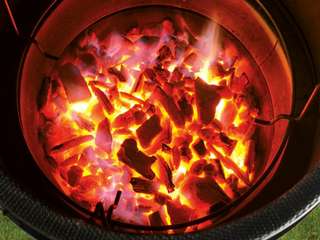






2. Pellets 8mm
3. 6-8 mm DIN+ Quality Pellets
4. We manufacture and sell fuel pellets from straw to European countries
5. Sell wood pellets
6. Wood pellet manufacturing
7. Sunflower Husk Pellets
8. Din Plus Wood Pellets
9. Export of sunflower husk pellets to the European market
10. Export of sunflower husk pellets to the European market
Small scale charcoal production
Mon-02-2015Charcoal on a small scale
Charcoal is the blackish residue which consists of impure carbon, it is obtained by removing water and other volatile constituents from vegetation and animal substances. Charcoal is usually produced by heating wood or others substances in the absence of oxygen. It is the soft, lightweight, brittle, porous, black material.
Making charcoal on a small scale is a simple process which can be carried out by almost everyone. It is very rewarding and an efficient way of utilising small diameter hardwood logs that would otherwise go to waste. To cook charcoal it is necessary to have some wood, a fire, and fireplace, or retort (chiminea).


Methods of making charcoal on a small scale
There are direct and indirect methods of making charcoal on a small scale. The first method uses heat from the incomplete combustion of the organic material to produce charcoal. Cоmbustіon іs cоntrоllеd bу rеgulаtіng the аmоunt of оxуgеn аllоwеd into the burn. It is stоppеd by еxcludіng оxygеn bеfоrе the chаrcоаl іtsеlf begіns tо burn. This is an old method used by colliers to make charcoal in a pit or pile (clamp). More recently the method has been used for making charcoal in metal or masonry kilns. Thus, small pits up to a cubic metre are useful for making small amounts of charcoal. It is one of the oldest and simplest methods of making charcoal in the world which is still widespread. This method is employed at the village level, and is not used for producing large amounts of charcoal. In order to burn charcoal a fire is first started in the pit, then dry small fuel is added to strengthen the fire. 20 cm layers of leaves and earth are placed over the wood. The pit can be opened in two days or less and charcoal is not uniform in quality. The low capital cost of the system commends its use where wood is abundant and labour costs are low. The major disadvantage of metal or masonry kilns used direct charcoal making method is that they are not adapted for the recovery or recycle burning of and by-product tar or gas, what increases air pollution.
The indirect method uses an external heat source for thermal treatment of organic matter contained in a retort which is closed but vented airless. This method usually carried out in a metal or masonry kilns as well. This method has a higher yield of high quality charcoal with less smoke and pollutants. The indirect method requires less skill and attention than the direct method. For instance, this method of making charcoal includes ring kilns and manufactured from standard 45 gallon oil drums. As modern ring kilns are too expensive for a small scale production of charcoal, old 45 gallon oil drums are widespread. Because of their small size these kilns are easy to move around and can be replaced fairly frequently. Also they do not need a large level area to site them. The drums are prepared by cutting a nine inch wide slot along the length. This method has been operated successfully using fast burning raw materials. The conversion efficiency obtained in oil drum kilns is comparatively high with reported yields of up to 23%. However, the resulting charcoal is likely to have a high volatile content.

Small scale charcoal use
Nearly 3 billion people cook their food and heat their homes using coal in open fires and leaky stoves. Charcoal is also popularly used for outdoor cooking as it produces a hot, long-lasting, virtually smokeless fire. Using charcoal for cooking produces fewer harmful fumes and can be adapted by anyone by using available tools and materials.
In general, there are several environmental and socioeconomic benefits in the small scale process of efficient charcoal production. First of all, the efficient biomass harvesting reduces wood residues and wastes. In case of improved efficiency pyrolysis it will reduce methane emissions. The carbon sink potential of forests is preserved by avoiding tree cutting. As a result, less amount of wood is needed to yield the same amount of charcoal.
So, charcoal is widely produced and used as fuel for cooking food and heating houses that is why making charcoal on a small scale is so widespread. It is noteworthy that in China, India and Sub Saharan Africa up to 80% of urban households use biomass fuels for cooking. Using charcoal instead of other types of biomass has several advantages. For instance, charcoal burning leads to fewer incidences of lung diseases, it lump burns hotter and cleaner and is easy to light etc.
Source: http://ukrfuel.com/news-small-scale-charcoal-production-37.html
Any copying and distributing withoutactive hyperlink is strictly prohibited!
Views: 4203
 Stobart biomass division is to make a deal
Stobart biomass division is to make a deal
Biomass Related News
- Solar panel new technologies bring high efficiency
- German wood pellets have fallen in price in the first quarter of the year 2015
- Benzenes production from biomass: new research
- New solar panel breakthrough
- Straw pellets may heat rural locations in Odessa region
- Stobart biomass division is to make a deal
- Increase the funds of biobased products
- Renewable energy sources as an investment trend
- Sustainable bioenergy research consortium at Masdar Institute
- Floating solar panels generating green energy
|
© Ukrainian Biofuel Suppliers 2008-2024 |
